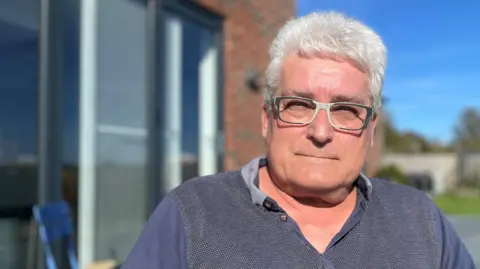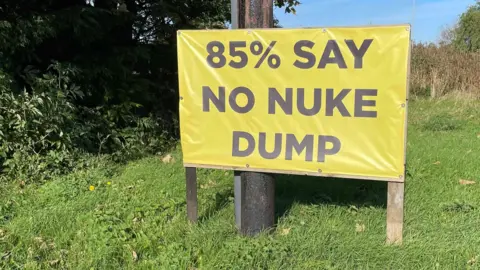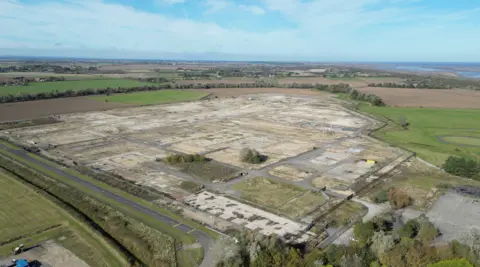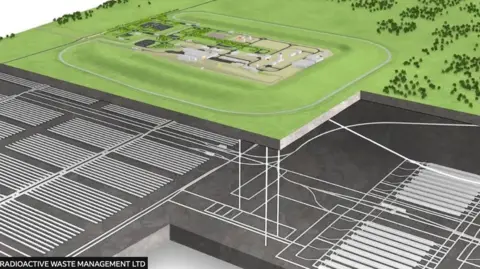'Nuclear waste would be disaster for our seaside'
 BBC
BBCCampaigners opposed to plans for a nuclear waste disposal site on the Lincolnshire coast say it could be "disastrous" for the seaside economy.
The former Theddlethorpe gas terminal on the Lincolnshire coast is one of three sites being considered for an underground facility.
Guardians of the East Coast (GOTEC) said a survey of more than 1,000 visitors to the resorts of Mablethorpe and Skegness found the "great majority" would be put off coming to the area.
Nuclear Waste Services (NWS), the government agency behind the plans, said the multi-million pound project would create jobs, improve transport links and boost the local economy.
GOTEC said it had carried out "extensive research" into the potential impact of the facility.
The group has produced a 60-page booklet called The Nuclear Option.
According to chairman Mike Crookes, the facility would "blight this area" and the economic impact on tourism could be "profound" and "catastrophic".

"The tourism industry in this area brings £600m of economic benefit and 8,000 jobs," he said. "We need to protect this at all costs."
A survey of 1,100 people along the coastline from Mablethorpe to Skegness, carried out by GOTEC, found "83% of them would not visit this area if that facility was built", Mr Crookes added.
NWS is considering the site for what is known in the waste industry as a geological disposal facility (GDF).
Other possible sites have been mooted in Hartlepool and Cumbria.
The GDF would see nuclear waste being stored beneath up to 1,000m (3,300ft) of solid rock until its radioactivity had naturally decayed.
The gas terminal would provide access to a shaft leading down to a tunnel, which would stretch up to 13 miles (21km) under the North Sea.
NWS is hosting a series of consultation events in the Theddlethorpe area to explain the plans in more detail and answer residents' questions.

The BBC asked visitors to the Lincolnshire coast for their views on the nuclear waste proposal.
Cara Swarbrick, from Leicester, was on a family holiday.
"If it's done in the right way it will be fine, but I am not sure how a nuclear waste site can be done in the right way," she said.
One local woman, who did not wish to give her name, was extremely opposed.
"It's the most dangerous stuff [nuclear waste] in the whole country," she said. "It's hot, high-level toxic waste".
Another visitor, Keith Spencer, was less concerned. "It wouldn't put me off coming here, provided it's a safe environment that it's stored in," he said.

Most of the radioactive waste generated by the UK's nuclear power stations is being temporarily stored at Sellafield in Cumbria, but longer term storage is needed for substances that remain hazardous for many thousands of years.
The idea of a nuclear waste site, or GDF, was first proposed for Theddlethorpe more than three years ago.
Local councillors have called for a referendum on the development.
According to the Theddlethorpe GDF Community Partnership, a facility would only be built in an area where the community "demonstrates if it is willing to host one", following a "test of public support", such as a referendum or consultation.
 Nuclear Waste Services
Nuclear Waste ServicesIn a statement, Nuclear Waste Services said: “There are many examples of thriving tourism industries in close proximity to nuclear sites, both in the UK and abroad.
"A GDF would positively transform the economy of a community through the jobs, skills, investment and infrastructure that will be needed for one of the UK’s largest infrastructure and environmental protection projects ever seen.
“The government has committed to providing multi-million-pound investment to the community that hosts a GDF. This investment could support better transport links which could help to enhance tourism in a local area.”
Listen to highlights from Lincolnshire on BBC Sounds, watch the latest episode of Look North or tell us about a story you think we should be covering here.
